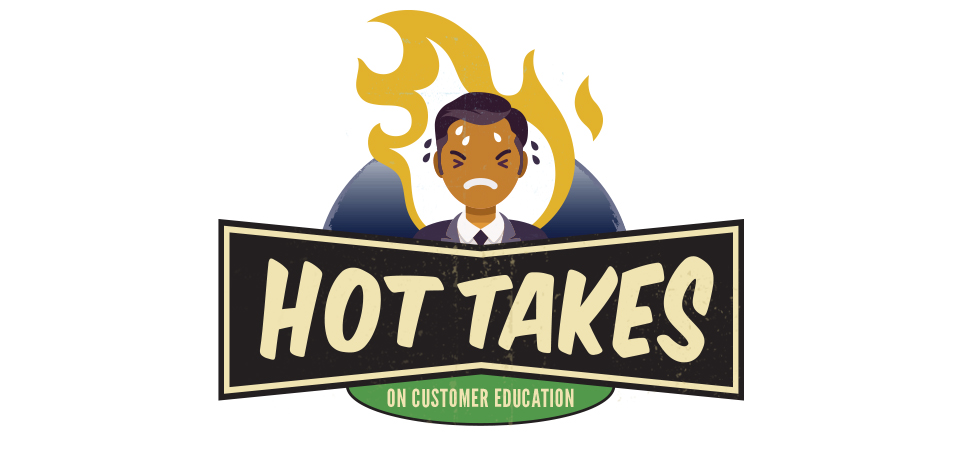It was so much fun to be asked to be a guest on Ryan Dillon’s Hot Takes, where he asks burning questions and discusses spicy opinions in the field of Customer Education. He even provides hot wings to match the mood! During the episode, I got controversial about how much online content we should create, and the best strategies for digital transformation and monetization.
Keep reading to hear how I believe you can take your customers’ taste buds from awareness to advocacy!
Hot Take #1: You Are Never Really a Team of One
Ryan asked me to share what I believe are the most important facets to focus on when you’re a team of one, often the case in the early stages of Customer Education in a company. This was fascinating to me, because when I was first learning about the Customer Education community and understanding what the domain looks like, I myself was (at times) a team of one.
Once I had my bearings, and I understood what the customer needed, I started to think intentionally about how to build Customer Education for these needs using a virtual team across the company. You’ll find that lots of people are doing parts of your role, and engaged in work that you could call Customer Education. As the subject matter expert in Customer Education, it’s your role to coordinate this work across different functions, and then communicate this to the executives. Ask yourself, where is the work happening, and how can you coordinate it for success?
The work could be happening anywhere, but think about Customer and Product Marketing, where you’re likely to find thought partners and tactical partners who understand the value of educating customers, as well as Customer Success and Enablement, who can also be a great resource.
It’s all about working that internal network, and of course this will vary depending on the size of the company. In a small company, cross-functional collaboration could be limited. The best thing to do is focus on the customer journey, and pinpoint who is supporting which parts of the journey, highlighting where you can help others, and where they can also make an impact.
Hot Take #2: Monetize Education Around the Customer Need
Next, Ryan and I moved onto a hugely contentious topic in Customer Education – fee vs free. Whether or not you’re monetizing, you need to think about the value and the impact of what you’re providing to the business. It could be the service itself, through direct revenues, or it could be a metric that will show value further down the line, like reduced churn or ticket deflection. Make sure you understand the business goals, and the decision-making behaviors of the people you work with.
When I was thinking about our first monetization package, I asked myself, what are customers willing to pay for? In my case, we needed to train a school, and help them enable and educate a number of their professional faculty. These students were paramedics, nurses, and dental hygienists, so their instructors weren’t necessarily professional educators. This was a clear need that the school was happy to pay for.
Everyone wants greater product adoption, but that might not be what customers are willing to pay for. If a customer wants change management, or coaching on how to make a shift to better technology, that might be a smarter move in terms of monetization, as it’s higher impact and can differentiate you from the competition. Bringing a Product mindset to your services offering can make a real difference, thinking about whether training is landing well, and whether customers are engaging with the learning.
Hot Take #3: Good Learning Was Always Enhanced by Technology
With so much digital transformation around us in the industry, the question came up: Has my opinion on online content creation and digital tools changed since the pandemic? Truthfully, I believe that all learning should already have been tech-enabled long before COVID-19, and nothing should have changed now.
Customer Education teams should certainly think about how to use digital tools to their advantage, and consider how to use both digital and non-digital experiences for learning. I believe digital tools work well for:
- Learning at a quicker pace, with better retrieval rates
- Facilitating microcontent – smaller and more focused chunks of learning
- Using multiple channels for reinforcing the same topic
- Remote learning, as long as there is a focus on engagement
- Reinforcing learning beyond the formal boundaries of a training session
In my opinion, we underestimate some of the more legacy or analog tools, which are actually very effective for a learning environment. Don’t be quick to discount rolling chairs, round tables, or whiteboards, which are all indicators of a good learning space, helping you to connect with people and collaborate as much as new technology.
The biggest thing I’ve observed has changed since 2020 is that the late adopters of digital solutions have been pushed across the chasm. Many people who may have been resistant to technology suddenly have a lot of opinions on their favorite and preferred tools! It’s been great to see what’s possible out there, and how learning can happen anywhere at any time.
Hot Take #4: Doing Less Online is Beneficial for Customer Education
One thing that the pandemic has shown me is that we vastly overestimate the load that we can put on a student. The rule of thumb pre-2020 was that online learners can handle 4-8 hours a week, but in reality it’s not possible anymore, especially if they are learning more than one topic.
Since then, I’ve solidified the opinion that doing less online is the smarter move, and the more you can pare back and get to the point – the better. Be direct, be specific, and tell students what they need to know, and nothing else. Your goal is to change the behavior, so do as little as you need to make that happen.
I’ve never been a fan of a training event where you sit down for an hour-long training webinar, or a half-day session. These types of events have their utility, and customer educators certainly rely on them, but what’s more important is the follow up, where you reinforce the learning and promote recall, and the ability to support learners in their moments of need.
Hot Take #5: Quality Over Quantity Every Time in Customer Education
We finished off our Hot Takes session by weighing up the value of more content versus better content. I’m going to go with… better content! Like I said before, take a Product mentality to your Customer Education program, and make sure you’re following the customer value.
Especially for a new program, great content will give you credibility, support the customer, and get you internal buy-in from people who can see that what you’re doing works.
Michael Di Gregorio started his education with a doctorate of philosophy at McMaster University in Ontario, later teaching Political Science and Psychology at the same institution. But Michael transitioned to the corporate world in 2015, when he started at Top Hat, holding roles including Instructional Designer, Client Onboarding Specialist, Team Lead for Classroom Engagement, Manager of Customer Success Enablement, and now serves as Director of Client Onboarding.



